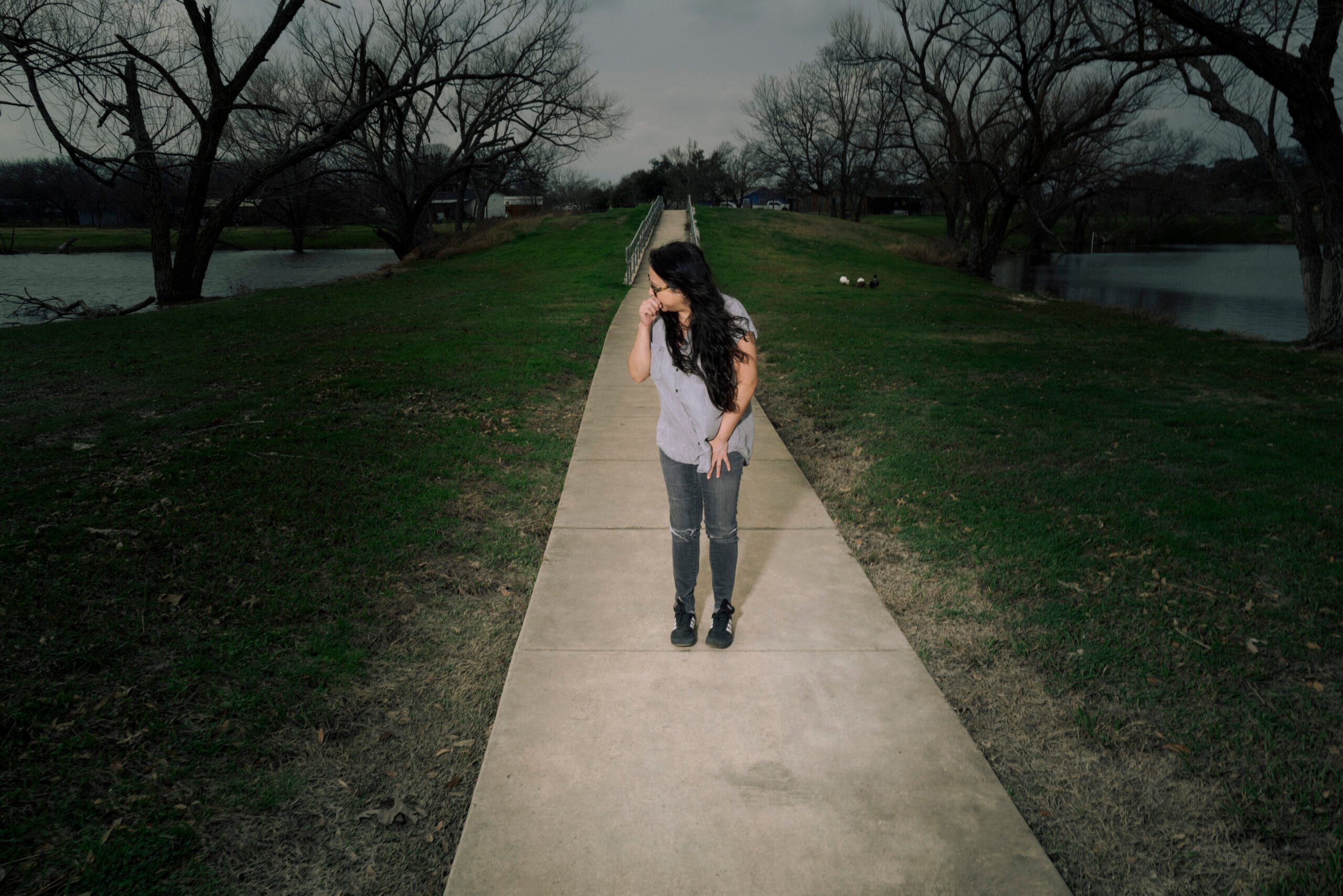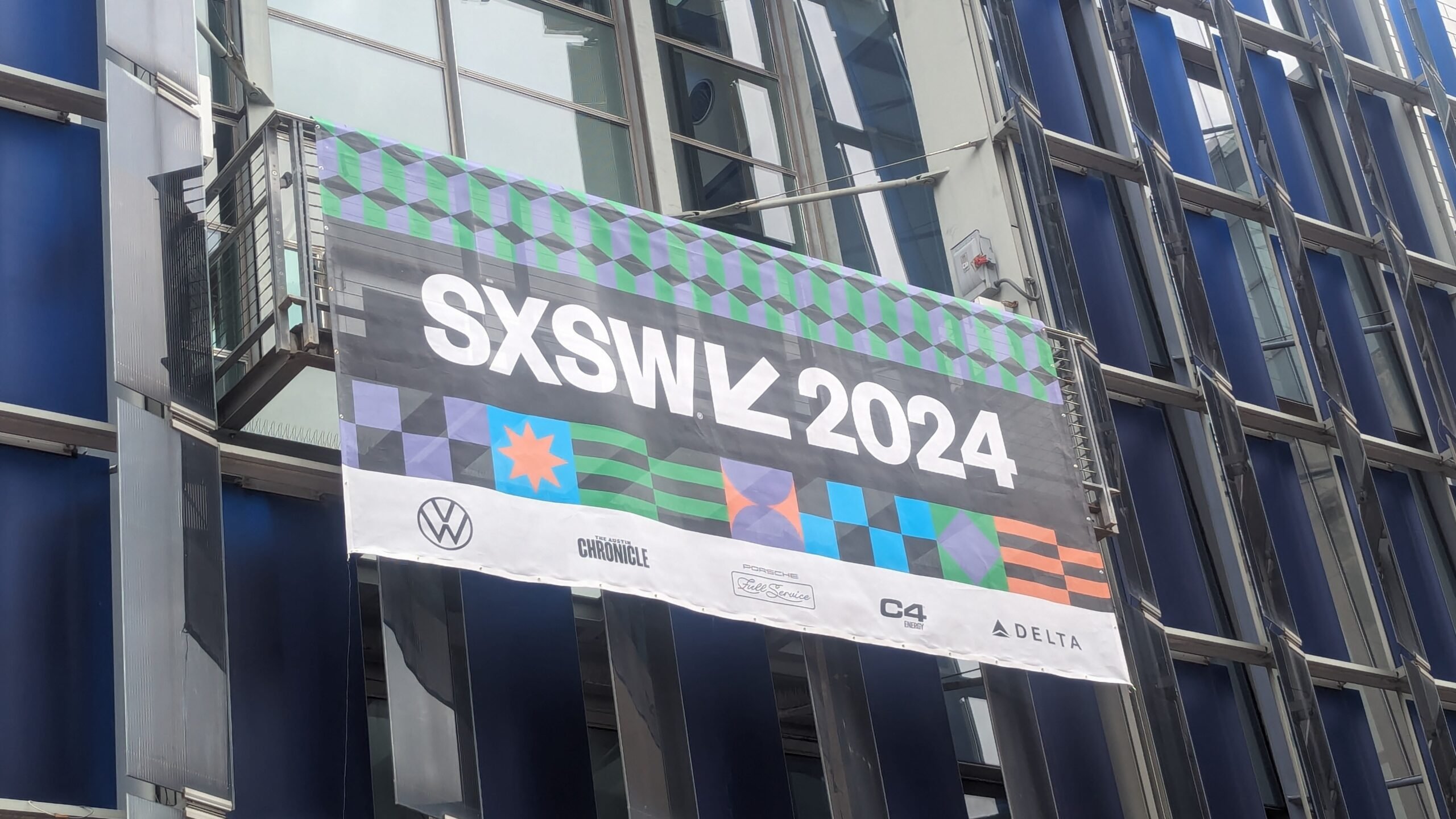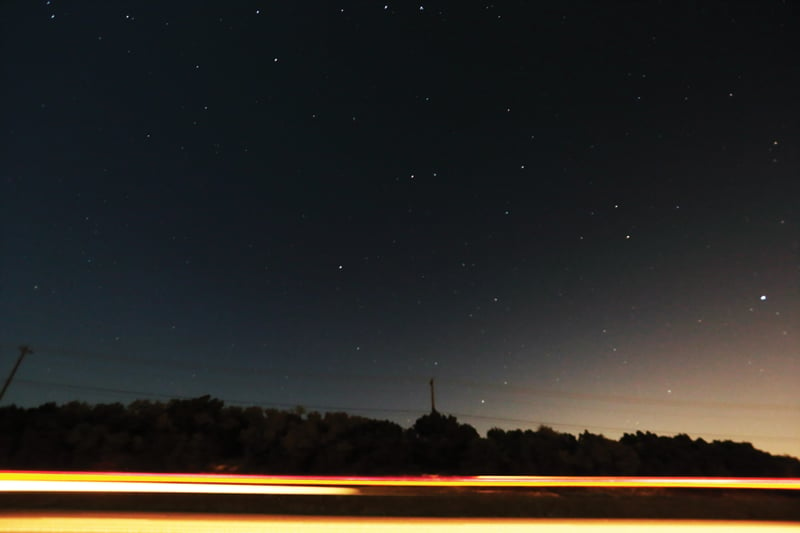
Seeing Stars in Dripping Springs
The stars are still big and bright in Dripping Springs thanks to an aggressive effort to combat light pollution. Will the rest of Texas follow this Hill Country town's lead?

A version of this story ran in the May 2014 issue.
Above: Austin’s glow as seen from a hilltop on US 290 in Dripping Springs.
The night sky lies so spent with stars that there is scarcely space of black at all and they fall all night in bitter arcs and it is so that their numbers are no less. —Cormac McCarthy, Blood Meridian
As a Hill Country tour guide, Cindy Luongo Cassidy offers an unusual route: No wineries or peach orchards or bucolic vistas of cedar-choked hills and cypress-lined rivers. No lavender fields or artisanal olive oil tastings. Her tour takes place at night, and its attractions are the lights of Dripping Springs. How few there are. And how dim.
Dripping Springs proper clings mostly to U.S. 290, which serves as the town’s main drag, an extended commercial strip that peters out west of town but blends into Austin’s sprawl to the east. Drippin’, as it’s known by locals, is home to just 2,000 people inside city limits, but more than 30,000 live within the town’s much larger extraterritorial jurisdiction.
Dripping Springs’ municipal motto—“Gateway to the Hill Country”—suggests the city is westward-looking, more in tune with its rural roots than with the buzzing boomtown glowing like a giant arc lamp 25 miles to the east.
Culturally, politically and ecologically, the area around Dripping Springs exists in an uncomfortable limbo between urban convenience and rural solitude—a tension exacerbated by the many Austin expats finding their way west. They seek the peacefulness and space of country living—and they bring commerce and development with them. They want the stars at night to be big and bright, but they want Home Depot, H-E-B and Sonic, too.
Cassidy, who serves part time as the city’s lighting consultant, wants to show me that both experiences are possible, and that the starry skies over Dripping Springs—and, by extension, over the Hill Country and maybe even urban Texas—can be preserved or restored even as the state’s booming population heaps insult on the first verse of “Deep in the Heart of Texas.”
Her tour starts at a large commercial development anchored by an H-E-B that opened in 2010. The lights on the tall poles in the parking lot are shielded, directing their glow downward into broad pools on the ground—more than bright enough for stowing groceries or spotting would-be muggers. Sheet metal installed behind fluorescent lighting in the multi-storefront awning keeps the light from reflecting off the stores’ front glass and into the eyes of drivers and pedestrians.
At the H-E-B gas station, Cassidy points to the LED lights recessed neatly inside the canopy over the gas pumps. The station is well lit, but not glaringly so. The light is directed downward at the business of pumping gas, not out onto the highway or up into the night sky.
The painstaking “smart lighting” approach on display here is largely the result of an aggressive push, led by Cassidy, to regulate outdoor lighting in Dripping Springs. Building on an agreement struck with the developer of the center, Cassidy helped write and champion a thorough outdoor lighting ordinance that the Dripping Springs City Council passed in 2011.
In February, Dripping Springs became the first city in Texas—and only the sixth in the world—to be certified a “Dark Sky Community” by the Tucson-based International Dark-Sky Association.
Though both Cassidy and City Administrator Michelle Fischer say there has been little opposition to the new lighting requirements, some businesses did initially resist.
“The contractor from H-E-B called me when I turned down what they wanted to do,” Cassidy says, “and he goes, ‘Honey, my wife would never go into a service station unless there were at least 40 foot-candles.” (A foot-candle is a measure of light intensity.)
Cassidy explained to the contractor that the Illuminating Engineering Society—an industry nonprofit that sets lighting standards—recommends 10 foot-candles for adequate illumination.
“I think he kind of stopped and said, ‘Oh shit, she knows what she’s talking about.’”
Cassidy, who wears an International Dark-Sky Association pin on her red blouse, is a lighting nerd. She has two different light-meter apps on her phone. She carries a sample fixture called a Glarebuster in her car in case anyone wants a demonstration.
Some people fight crime. Some people fight city hall. Cassidy fights light pollution. She says she is driven by an abiding obsession with glare and a life-long interest in astronomy. As a child growing up in rural Virginia, she followed her dad on camping excursions to nearby farms with open fields. “As the fire would burn down, you’d look up and just be amazed at the number of stars,” she remembers. “I thought it was so peaceful.”
Cassidy’s pitch is this: In our well-meant effort to light our way at night, we’ve illuminated our cities and towns in a way that is inefficient, wasteful and unsafe, and that increasingly prevents us from seeing stars at night.
Instead, with moderate expense and effort, we could use smarter lighting to accomplish the same thing without turning the night into day.
Behind the wheel of her SUV, Cassidy recounts the relative merits of the town’s gas stations—often some of the worst offenders in the light-pollution business.
“They recently re-did the canopy on the Shell, so that’s nice,” she says. “They still have some bad wall-packs on the back, but we’ll get ’em.”
She notes that Stripes, a Corpus Christi-based chain of service stations, has committed to retrofitting the outdoor lighting at its 565 locations in Texas, New Mexico and Oklahoma. Out with the ultra-bright fluorescent lighting; in with lower-watt LEDs.
“We’ve got an O’Reilly’s up here,” she says, wheeling her car off 290 into the parking lot.
“They wanted to light that thing up like nobody’s business. But see, it’s very gently lit.” O’Reilly Auto Parts installed a dark film on its storefront windows to cut the amount of light leaking out from the interior’s fluorescent bulbs.
But the law’s reach extends only so far. Of the unbelievably bright private ballfields in unincorporated Henly, which we can see from miles away, she says, “It’s like being in the gulag.” The 18-acre complex, which lies beyond Dripping Springs’ jurisdiction, is called Field of Dreams Park. Neighboring farmers complain that their goats and horses can’t get any sleep because of how bright the night sky is now.
Farm animals in Dripping Springs, on the other hand, rest easy, their circadian rhythms intact.
“It’s one of the best ordinances I’ve seen,” says Bill Wren, a special assistant to the superintendent of McDonald Observatory in Fort Davis, and Texas’ foremost authority on dark skies. “It can serve as a model for lots of communities.”
And Fischer says people embraced the idea once they learned about it.
“There was a huge amount of support for it,” Fischer says. “Once people understand it, it’s very difficult to not be for it.”
The ordinance limits the total amount of lighting—on a lumens-per-acre basis—that a residence or business can install, and requires that light be fully shielded so that it stays on the property. Fundamentally, the ordinance is built around the legal notion of trespass. If your light falls on someone else’s home or business or barn, that’s considered trespass under the Dripping Springs ordinance, and can lead to fines.
The city has committed to replacing all city-owned lighting within five years. Existing lighting is grandfathered in, but the ordinance has all sorts of “triggers”—for example: a business remodels or expands—to enforce the change to smart lighting. Bulb by bulb, fixture by fixture, Dripping Springs is turning down the lights.
The overall effect is subtle, but unmistakable. The nights are still dark in Dripping Springs. Look up and you can see something most of us in Texas’ big cities and ever-expanding suburbs, exurbs and oil patches seldom see: light from distant galaxies, planets and suns spread across the heavens.
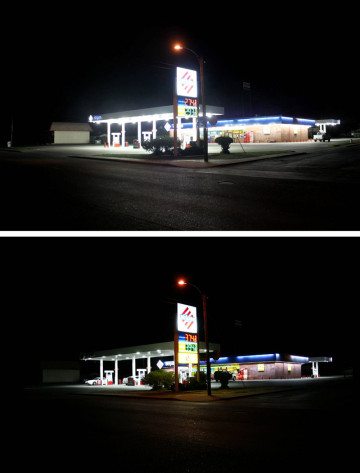
When I was 5, I watched Halley’s Comet from the pasture in front of our house in rural South Texas. The night sky was dazzling. With a pair of low-powered binoculars, we could see the tail of the comet, which approaches Earth every 75 years. It’s one of my earliest memories, and I grappled with what my parents told me: that they would never see Halley’s Comet again, and that I might not either. But other comet-watchers across the nation were disappointed with the comet’s much-hyped appearance. The main problem was that the comet was on the opposite side of the sun from Earth, but astronomers and the media also blamed light pollution, in part, for Halley’s unexpectedly poor showing. People had planned to gaze skyward, as our ancestors did, with the same sense of awe and bewilderment the ancestors had reported, and to later tell stories about the potentially once-in-a-lifetime sight. But for the first time in human history, our species’ success at conjuring light from energy—mostly fossil fuels—helped render the comet unseeable for most people.
Light pollution has only gotten worse since Halley’s last pass in 1986. Current satellite imagery depicts much of North America as a chiaroscuro of white-hot cities punctuating the shrinking rural darkness. In Texas, the I-35 corridor from San Antonio through Austin, Waco and into Dallas-Fort Worth presents itself as a string of bright-white pearls nearing a solid band of illumination.
The fracking boom of the past decade has transformed even parts of rural Texas with sky glow visible from space. The Eagle Ford Shale, which stretches from Laredo northeast into East Texas and includes the area where I watched Halley’s Comet as a child, shows up on satellite maps as a bright band—the image of a drilling frenzy attended by flaring and widespread use of intensely bright lights on rigs and infrastructure. Even at ground level, the region’s transformation is startling. What used to be dark expanses of farms and ranches and itty-bitty towns are now lit up in spots like a Broadway show.
Another oil and gas boom, in West Texas’ Permian Basin, is now threatening the state’s last bastion of dark skies: the far West Texas and Big Bend regions, which boast skies so brilliantly starry they’ve become the standard by which Texas skies are measured. Two out of three Americans can’t see the Milky Way from where they live; out around Fort Davis, it’s so luminous as to be intimidating.
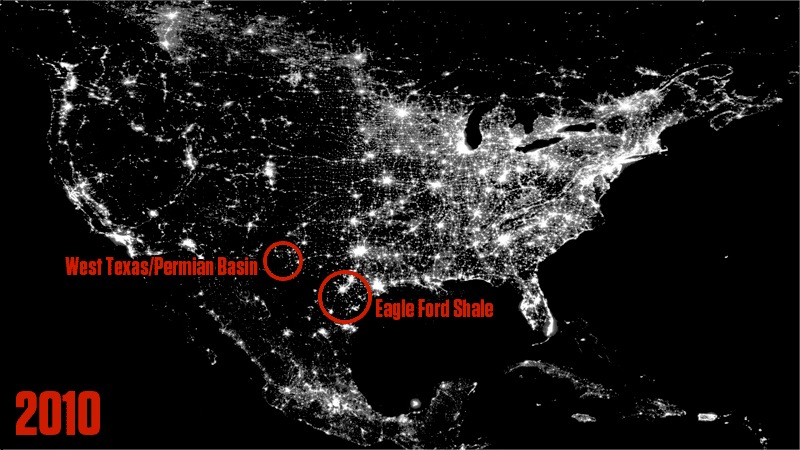
Nobody knows more about that than Bill Wren. Wren and I met over migas one morning at a South Austin taqueria. He’d been on the road for two weeks, traveling with his cat, trying to convince the oil and gas industry to use less intrusive lighting. Earlier that week he’d been climbing around a rig south of San Antonio, showing the crew how shielding and directing their work lights could improve visibility and safety.
“They are tickled pink with the shields we put on the platform,” Wren said.
Before that, he’d attended a meeting in Fort Worth of the Texas Independent Producers and Royalty Owners Association, where he tried to convince royalty owners to write dark-sky clauses into their leases.
In 1990, Wren—then an amateur astronomer with a part-time gig tutoring at the University of Texas at Austin—landed a job at the McDonald Observatory. During his second month on the job, his boss tasked him with attending a meeting of the recently formed International Dark-Sky Association.
“I went to that meeting and forgive the pun—the light went on over my head,” he says. “We can light our city streets well, we can light our property well, and protect the night sky in the process. It’s not a conflict. That realization just got my enthusiasm going, and it’s been part of my job responsibilities ever since to keep the skies dark for McDonald. Right now I’m failing miserably as far as oil and gas activity goes.”
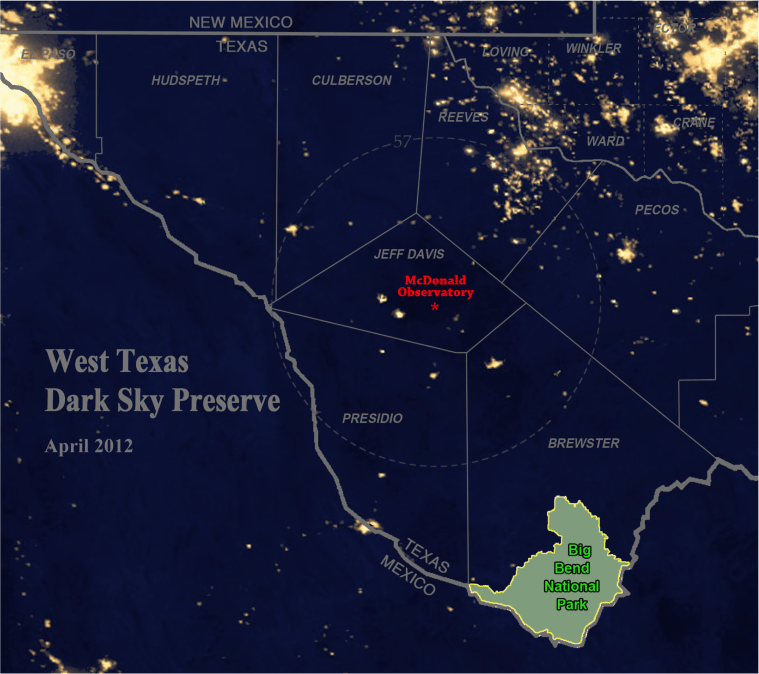
Wren shows me photographs on his computer of the night skies around McDonald—one from 2001 and one taken recently. The first is a time-lapse series of a stunning aurora display playing out in the kind of night sky that’s known to bring people, seeing it for the first time, to tears.
The second image, taken within the last year, is of a typical sky scene. It is captivating even on a 14-inch laptop screen, but a dull glow shows along the horizon to the east, like a car’s high-beams behind the crest of a hill. That’s oil and gas activity advancing on the observatory—a potentially mortal threat to the nation’s largest optical telescope, which happens to be located in the middle of the nation’s largest dark-sky preserve.
The seven counties surrounding McDonald Observatory, encompassing more than 28,000 square miles, are subject to mandatory outdoor lighting rules enabled by the Texas Legislature in 2011. But Wren, who pushed for the legislation, says enforcement is virtually nonexistent, especially when it comes to oil and gas facilities. “I’d say their enthusiasm is underwhelming,” Wren says of most county officials.
Wren hopes to convince the oil and gas industry—not to mention cities—to adopt better lighting. “The technology is there to do lighting well. Dripping Springs is full of good lighting. Awareness, education; it’s 10 percent hardware and 90 percent education.”
Unlike many environmental woes—climate change, for instance, or the extinction of species—light pollution is eminently reversible, even in big cities.
“The stars aren’t going away,” Wren says. “We haven’t done anything to them. We’re just blocking our ability to see them.”
But still, Wren hears one question a lot: Why do we need to see the stars? The ability to see our more immediate surroundings at night, after all, represents one of the signal triumphs of civilization. For millennia we stumbled in the dark, spooked by apparitions and spirits, cocking our ears fearfully toward the keening of animals that could kill us. Night light represents modernity and the comforts of urban life. Who doesn’t marvel at the lights of Paris or take pride in the twinkling skyline of New York City? I always get a thrill driving back from Big Bend—after sleeping out beneath the stars beside the Rio Grande—when I near Austin and see its welcoming glow.
Wren has a well-rehearsed answer.
“Who cares? Good question. This might be kind of clichéd, but if Van Gogh were alive today, would he be inspired to paint ‘Starry Night’ again? In Saint-Remy, France?” He cues up a light map of France, pinpointing Saint-Remy in an area with plenty of light pollution. “I don’t think so.
“What are we losing by not being able to see the starry skies? I think it’s difficult to imagine, but I think there are significant consequences. Imagining worlds beyond our own horizon, just that cognitive ability. How do you expect the kids to reach for the stars if they can’t see them?”
I now live in Austin, and I don’t even bother to gaze upward much. I’m lucky to see a few dozen of the brightest stars when I do, though there are thousands and thousands trying to pierce through.
One obvious challenge for the dark-sky movement is how to get people to care about something they may not know they’re missing. Not everyone has the privilege of visiting West Texas for a yearly reminder of the power of a starry sky. In 1994, Los Angeles suffered a blackout that left millions of Angelenos without power. Many people were so startled by the thousand points of light in the sky that they called a local observatory seeking explanation. “For the first time in their lives, many citizens of Los Angeles had seen the stars,” the Los Angeles Times Magazine wrote in 1999. “And they didn’t know what to make of them.”
But rural residents know what they stand to lose, and Christy Muse, executive director of the Hill Country Alliance, an influential ecology-oriented nonprofit, confirms that the dark-sky movement is led by people in rural areas who want to protect what they already cherish.
“A lot of times, the environmental movement is viewed as coming out of the urban areas,” she says. “It’s perceived as something pushed by urban environmentalists into the rural areas. On this issue, it’s completely the opposite.”
Muse says several Hill Country communities have identified reduction of light pollution as a priority for reasons related to both tourism and quality of life. In Kimble County, where rolling hills give way to the deserts of West Texas, the county judge and a citizens group worked with the Alliance to secure funding to replace the city’s streetlights with low-wattage LEDs. “They said it made a big difference,” Muse says, and “it made those remaining lights that are a problem really stand out.”
Blanco has taken a more voluntary approach than Dripping Springs, rewarding businesses that adopt smart lighting with recognition by the Chamber of Commerce. Other cities, including Fredericksburg and West Lake Hills, are looking to Dripping Springs as an example. Fischer, Dripping Springs’ city administrator, plans to hold a two-day lighting seminar in August to educate government types and citizens from across Texas.
But even with an aggressive approach like Drippings Springs’, there’s only so much small communities can do. Government’s reach in unincorporated areas of Texas is notoriously constricted. And as the pace of development quickens in rural parts of the state, the challenge grows.
Muse says that short of the Legislature empowering counties to take more control over lighting, activists will have to fight subdivision by subdivision to convince developers to use smart lighting.
“The problem is—and this is what’s got to have something done about it—is the state of Texas won’t allow the counties to protect the property rights of those of us in incorporated areas,” Cassidy says.
On the March night when Cassidy showed me around Drippings Springs, the skies were overcast and we were unable to see a single star. But in early April, Cassidy and her husband, John, invited my girlfriend and me to their house on Onion Creek in Driftwood, near Dripping Springs. The couple has a second-story deck built over a garage with a powerful telescope and a “sky window”—a nifty device that uses a mirror to let you peer at the sky through a pair of high-powered binoculars, hands-free.
We watched the sun dip below the horizon and then the stars—and the artificial lights—began blinking on as dark settled. Cindy pointed out the abundant sky glow. To the northwest we could see a mini-nova from the ballfields at Dripping Springs High School. An auto-parts store on a road miles away twinkled at us. The I-35 corridor was lit up to the east and southeast, a whole horizon awash in light from Kyle to San Antonio. “What’s that?” my girlfriend asked about the purplish-white halo to the northeast. It was Austin.
“The first night they turned on the Frost Tower, I said, ‘What the heck is that?’” Cindy said. “We lost a good chunk of our sky.” Cindy said she and John drove into Austin to take a closer look. The lighting on the new building was so powerful, and so poorly managed, that it was affecting the night sky 20 miles away.
Using an iPhone app called Dark Sky Meter, Cindy took a dark-sky reading. The app employs the phone’s camera to gauge brightness, which can then be shared on a map alongside other users’ readings.
“Ewww, only 18.96,” she said. On the scale, 22 is a “dark sky”; up to 18 is a “city sky.”
“I don’t want to report that because it’s embarrassing. When the moon’s not out we get 21, and that’s wonderful.”
Still, it was dark out there. Not West Texas dark, but dark enough to see many of the constellations with the naked eye, even with a half-full moon.
Jupiter was the first visible point in the sky. We took turns peeping at it through the telescope. We could clearly see the brownish bands of gas streaking the planet’s girth, and four of the moons appeared as brilliant points of light nearby. We found the International Space Station low on the western horizon, zipping along in orbit 230 miles above Earth.
We identified Orion, and John dialed in the middle of the three stars of Orion’s sword. I could see that the middle star is not a star at all, but a cluster of stars known as the Trapezium, surrounded by a misty-looking cloud, the gaseous nebula from which the stars were born. The telescope allowed us to resolve the hunter into his constituent parts and to identify, across vast distances, celestial bodies invisible to the unassisted human eye, and to our ancestors, who gave form and name to the constellations.
With a telescope, John suggested, “They would’ve looked at the small picture rather than the big picture.”
Later, back in East Austin, I downloaded an app, Star Walk, which turns your phone into a real-time star map, and climbed the hill behind my house. There were a few dozen stars above my backyard. I located the North Star and Mars, I think, but there wasn’t much else to see. Disappointed, I tried to catch a glimpse of the downtown skyline through the trees.
To support journalism like this, donate to the Texas Observer.
